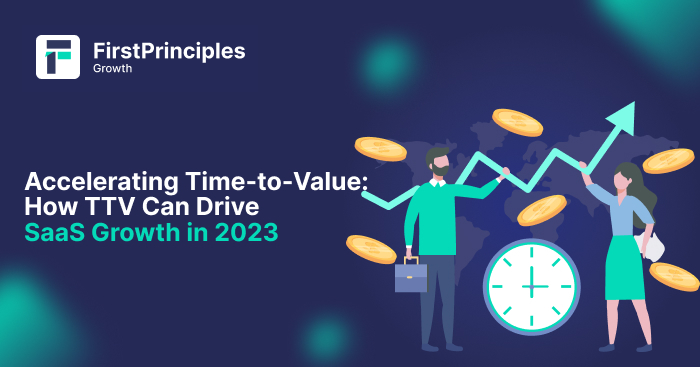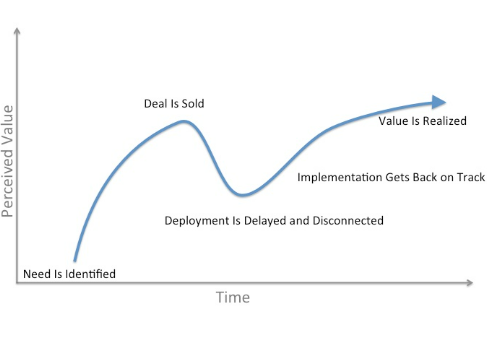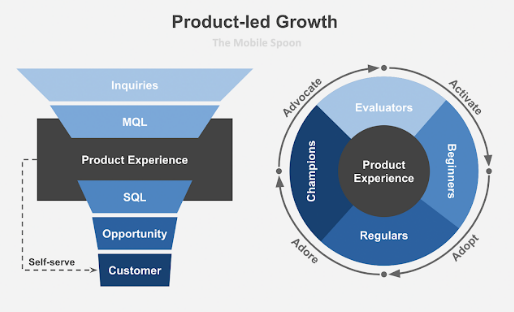
Home > Accelerating Time-to-Value: How TTV Can Drive SaaS Growth in 2023
Table of Contents
ToggleAs we gear up for another exciting year in the SaaS industry, it’s clear that companies are honing in on a new metric that’s sure to set them apart: time-to-value (TTV). A recent survey found that a whopping 65% of SaaS companies have made accelerating TTV a top priority for 2023.
However, what exactly is TTV, and why is it such a big deal? TTV is the time it takes for a customer to start experiencing value from a product or service after signing up.
Customers seek immediate results and value when adopting a new product, prioritizing swift access to its benefits. In today’s fast-paced world, waiting weeks or even days to experience the advantages of a new product can be challenging. Customers appreciate prompt value realization, driving the need for shorter timelines.
That’s why TTV has become such a crucial metric for SaaS companies. It is not just about how quickly a product can be delivered but also how quickly it can be adopted and integrated into the customer’s workflow. And if companies don’t prioritize TTV, they risk losing customers to competitors who can deliver faster value.
Stay tuned as we explore each of these in detail and share some actionable tips to help you improve your TTV and boost your SaaS growth in 2023!
In simple terms, TTV measures the time it takes for your customers to realize the value of your product after they sign up.
The formula for calculating TTV is simple:
TTV = Value Received – Time to Receive Value
The goal for SaaS companies is to minimize the time it takes for customers to start experiencing value, while also maximizing the value they receive.

Imagine you’ve invested your time and money into a product but don’t see any results. Would you stick around? Probably not.
This is why a shorter TTV is crucial for any SaaS company. Customers who can quickly see the benefits of your product are much more likely to become long-term users.
[Image Source: Baremetrics]
On the other hand, a longer TTV could be a red flag. It could indicate that customers are struggling with the onboarding process or that the user experience is not up to par. Ultimately, a longer TTV could lead to a higher customer churn rate. Of course, TTV can vary depending on the complexity of your product and the type of users you’re targeting.
For example, if you offer highly technical enterprise products, your TTV could naturally be longer. It could take weeks or even months for users to learn and integrate your software into their workflow.
But here’s the thing: TTV can directly impact your revenue growth. According to McKinsey & Company, reducing your TTV by just one week can increase revenue growth by 70%. That’s a massive impact!
So, how can SaaS companies accelerate their TTV and stay ahead of the competition? By focusing on three key areas:
To measure TTV, you first need to understand what value means to your customers. Is it saving time, increasing efficiency, or reducing costs? Once you’ve defined the value, you can use tools like user analytics and surveys to track the customer journey and identify when they first experience that value.
Note that TTV will vary depending on your product’s complexity and your customers’ needs. For example, if your product requires extensive training or integration with other systems, TTV may be longer than for a more straightforward product. Let’s check out different types of TTV and how to measure it:
Time to Basic Value
This is the time it takes for a customer to derive some value from your product or service. This can be as simple as using a basic feature or receiving a small benefit. For example, if you offer project management software, your customer may derive basic value by using the task management feature or by tracking their time using your time tracking feature.
To measure the time to basic value, here’s the formula:
Time to Basic Value = Date customer signed up – Date customer first received value
Time to Exceeded Value
This is the time it takes for a customer to experience enough value to purchase your product or service. This often happens after a free trial, during which the customer has had the chance to explore your product’s features and benefits.
For example, a customer may decide to purchase your project management software after realizing how much time it saves them in their daily tasks.
To measure the time to exceeded value, you can use the following formula:
Time to Exceeded Value = Date customer signed up – Date customer upgraded to paid version
Long Time to Value
This is the metric that measures your TTV when a product or service takes a long time to deliver value to the customer.
Long Time to Value can be a challenging hurdle for some businesses to overcome, especially in the competitive world of B2B SaaS. However, note that not all products or services are created equal when it comes to Time to Value. For example, a project management software may have a shorter Time to Value than a complex enterprise resource planning (ERP) system.
To measure the long time to value, use the following formula:
Long Time to Value = (Date value delivered – Date customer signed up) / Number of days to deliver value
Short or Immediate Time to Value
Imagine signing up for a B2B SaaS platform and feeling like a kid in a candy store because you can start using its features right away. That’s the short or immediate time to value in action! It’s like ordering food at a restaurant and having it served at your table within minutes. It’s instant gratification and makes you feel good about investing in the product or service.
To measure the short or immediate time to value, you simply need to subtract the date the customer signed up from when the value was delivered.
Short or Immediate Time to Value = Date value delivered – Date customer signed up
For example, if you signed up for a B2B SaaS email marketing platform on January 1st and sent your first email campaign on January 2nd, your short or immediate time to value would be just one day.
To optimize TTV, it’s crucial to understand what “value” means to your customers and identify potential roadblocks in the onboarding process.
By identifying and addressing these roadblocks proactively, you can reduce the time it takes for customers to realize the value of your product and improve customer retention.
Did you know that 70% of customers expect to see value from a SaaS product within the first 30 days of purchase? That’s a huge number! And to make matters even more interesting, 80% of customers who experience value within the first month are more likely to stick around and renew their subscription.
So why is TTV so important? Because it’s all about the customer experience.
When someone signs up for your SaaS product, they want to know that they made the right decision and that they’ll start seeing results quickly. If they don’t, they might get frustrated and wonder if they wasted their time and money. Nobody wants that!
On the other hand, if a customer starts seeing value right away, they’ll be thrilled. They’ll be more likely to keep using your product, tell their friends and colleagues about it, and maybe even become one of your biggest advocates. That’s what we call a win-win situation!

[Image Source: Mobilespoon]
Faster time to value (TTV) is a critical metric for SaaS companies as it directly impacts customer satisfaction, retention, and, ultimately, revenue. There are several challenges that SaaS companies may encounter when trying to achieve a fast TTV.
Here are a few of the most common challenges:
Ensuring the product aligns well with the customer’s needs is crucial for providing value quickly. If the product doesn’t solve the customer’s problem or meet their expectations, it may take longer to achieve a fast TTV.
If the product is complex or difficult to use, customers may require extensive onboarding and training to get it up and running. This can slow down the TTV and lead to frustration and churn.
For SaaS products that require data integration, the process can be time-consuming and complex. This can delay the time to value and make it more difficult for customers to see the product’s benefits.
If the product requires significant customization for each customer, it can be challenging to provide value quickly. This can slow down the TTV and make it more difficult to scale the product.
Technical issues such as bugs, glitches, and downtime can significantly impact the TTV. If customers cannot use the product due to technical issues, it can delay the time to value and lead to frustration and churn.
✔️Implement automation
✔️Use product analytics to identify bottlenecks
✔️Improve user engagement through gamification
✔️Implement a feedback loop to improve the product continuously
✔️Offer customer support through multiple channels
✔️Provide easy-to-access product documentation
✔️Provide a self-service knowledge base with video tutorials, FAQs, and documentation.
✔️Offer live chat support to address customer questions or issues quickly.
✔️Use in-app notifications to guide users and highlight key features.
✔️Provide a guided tour of the product to help users understand how it works.
✔️Offer templates and pre-configured settings to help users get started faster.
✔️Simplify the user interface and reduce the number of steps needed to complete tasks.
✔️Use data analytics to track customer behavior and identify opportunities for improvement.
Have you ever subscribed to a new SaaS product, only to be met with a confusing interface.
Well, AI is here to save the day! SaaS companies can use AI algorithms to provide a personalized onboarding experience.
Think of it like having a virtual assistant that walks you through the product step-by-step, tailored to your unique needs and preferences. This makes it so much easier to see the value of a product when you have a personalized onboarding experience.
But that’s not all AI can do. It can also help accelerate the time to value (TTV) through predictive analytics and dynamic pricing. By analyzing your behavior, AI can predict which features you’re most likely to use and what actions will drive value for you. This means you receive personalized recommendations and guidance that help you get the most out of the product faster.
And with dynamic pricing, AI can optimize pricing strategies to offer personalized pricing options and discounts, incentivizing customers to use the product more frequently and realize its value more quickly. Pretty cool, right?
What are the Other Product-Led Metrics Where You Need to Focus?
Are you a SaaS company looking to boost your growth? Well, there’s more to it than just tracking TTV. There are a handful of other product-led growth metrics that can help you better understand your customers and drive your business forward.
Let’s start with MQLs or Marketing Qualified Leads. These are people who have shown some interest in your product, but they’re not quite ready to pull out their wallets yet. By tracking MQLs, you can get a sense of how effective your marketing efforts are at attracting potential customers.
Next up is CAC, or Customer Acquisition Cost. This metric helps you understand how much it costs to acquire a new customer. If your CAC is too high, it might be time to rethink your marketing or sales strategy.
Once you’ve attracted potential customers, it’s time to qualify them. Tracking Sales Qualified Leads (SQLs) can help you focus your sales efforts and improve conversion rates.
Then there’s PQL or Product Qualified Leads. By tracking PQLs, you can understand how engaged your users are and which features are resonating with them.
These metrics can help you better understand your customers and improve your growth strategy.
As a SaaS company, you’re probably always looking for ways to drive growth and retain customers, right? Optimizing Time-to-Value (TTV) is a surefire way to do just that in 2023!
Think about it: if customers don’t quickly see the value of your product, they’re likely to lose interest. But by providing a personalized onboarding experience using AI-powered tools, you can help them see the value faster. It’s like giving them a map of the treasure instead of leaving them to wander aimlessly in the forest.
And it’s not just about getting them to see the value faster – it’s also about continually improving your product to meet their evolving needs and preferences. By analyzing user data and gaining insights, you can stay ahead of the curve keeping your customers engaged and loyal.
Moreover, by automating manual tasks with AI, you can free up resources as well as allow your team to focus on what really matters: innovation and improving the product.
So, let’s recap:
Sounds like a winning formula!
Looking to accelerate your SaaS growth in 2023? Let us help you optimize your Time-to-Value (TTV) and drive sustainable growth.
Ameet Mehta‘s expertise lies in building revenue engines for technology-enabled companies and private equity investments. He began his journey with TechStars Chicago and has since founded and acquired several companies through FirstPrinciples Holding Company. The FirstPrinciples portfolio generates over $7M in revenue/year with most companies in the SaaS space. He...